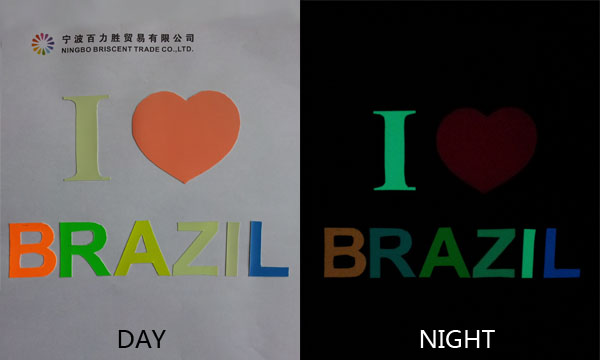
Introduction
Photoluminescent Pigments are alkaline earth aluminates long afterglow materials. When Photoluminescent
Pigments absorb visible light about 5-20 minutes, they can store the lights as an energy in their crystal lattice,
then transfer the energy to luminous energy in dark environment. They continue luminescent for about
8-14 hours. Photoluminescent Pigments can be repeatedly recycled and used without electric source.
The excitation light source can be sunshine, general lights, stray lights of environment. Photoluminescent
Pigment is non-toxic, non-radioactive, and chemical property stable. Due to the good properties
of ageing resistance, corrosion resistance, heat resistance(resistant high temperature 250℃), flame retardant resistance and
scratch resistance, Photoluminescent Pigments are used as additive agent in deferent kinds of transparency medias, such
as coatings, printing inks, paints, plastics, printing paste, ceramics, glass, fiber etc. Particle size is 10~20 micron.
Range
|
Range |
Color |
Other |
|
General Photoluminescent Pigments |
yellow-green |
|
|
Color Photoluminescent Pigments |
Red, yellow, blue-green sky-blue, violet, green |
|
|
Invisible UV excitation Photoluminescent Pigments |
White, red, green, yellow, blue violet |
Excitation wavelength:365nm |
|
Special used Photoluminescent Pigments |
------ |
Mainly used in drawing of the upscale recreation area and the product quality examines
|
Application
Application in coatings and printing inks Photoluminescent Pigments can make luminescent coatings and inks with many kinds
transparent resins, such as acrylic resin, urethane resin, epoxy resin, amino resin, PVB resin, polyvinyl butyral resin, polyamide
resin, etc. The resins should be dissolved in appropriate solvent, and then Photoluminescent Pigments can be put. The usage
of the resins are 10%-50% in coatings; 30-60% in inks. At last, suitable anti-settling agent, antifoaming agent,
dispersing agent are mixed into the container with high-speed mixer. Don’t use vertical roll to grind Photoluminescent
Pigment, in case that will destroy their luminescence characteristics. If you use sand mill, the mixing time should be as short
as possible. The fundamental purpose is to disperse Photoluminescent Pigment.
Examples:
|
Example 1 |
Example 2 |
||
|
Ingredient |
%wt |
Ingredient |
%wt |
|
Photoluminescent Pigment |
35 |
Photoluminescent Pigment |
50 |
|
Acrylic resin |
38 |
Acrylic resin |
30 |
|
Xylene |
7 |
Xylene |
7 |
|
Butyl Acetate |
8 |
|
|
|
Antifoaming Agent |
appropriate amount |
Antifoaming Agent |
appropriate amount |
|
Dispersant R-920 |
1 |
Dispersant Byk-300 |
1 |
|
Fumed Silica |
0.8 |
Fumed Silica |
7 |
|
The products can be used in painted panel, dial etc. |
|||
Application in plastic
Photoluminescent Pigments can make plastics with many kinds transparent resins, such as PE, PP, ABS, PVC etc. With the
methods of extrusion, injection molding, blow molding, vacuum forming, etc, they can be manufactured into varied plastic
products. Usage: 4%-5%.
Photoluminescent Pigments seem to be fear of iron. They will become black and the luminous property will drop when they
contact with iron. Therefore, the contacting time and intension with iron should be reduced during the entire production
process. The mixing time of powder should be minimized as far as possible. If the condition is premised, you can modify the
mixing equipment to separate Photoluminescent Pigments and iron and choice the injection molding machine with shorter
heating tube to control the molding temperature and pressure.
Attentions
1、 Most Photoluminescent Pigments are slightly soluble in water, decompose in acid, so they can’t be used in water-
soluble and acid system (except those specially marked ).
2、 These kinds of pigments have specific gravity, so pay attention to mix when use them.
3、 It should be preserved in ventilated, dry conditions, cared about moisture. If they can’t be used up at once, they
should be sealed saved.
4、 Metal materials have great influence on luminescent properties, so avoiding contacting with metal materials.
5、 Package: Using waterproof plastic bags for inner packaging, plus desiccant and using carton or iron drum for outer packaging.
6、 Transportation: Prevent mechanical impact and pressing, keeping package integrity, keep away from sunshine and raining
and no inverted.
7、 Storage: Pigments should be stored in ventilated, dry environments, cared about moisture.